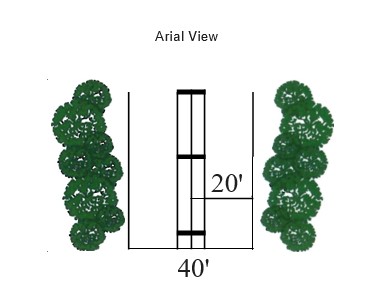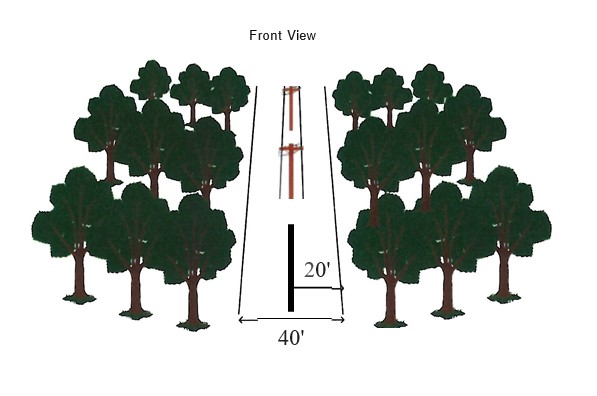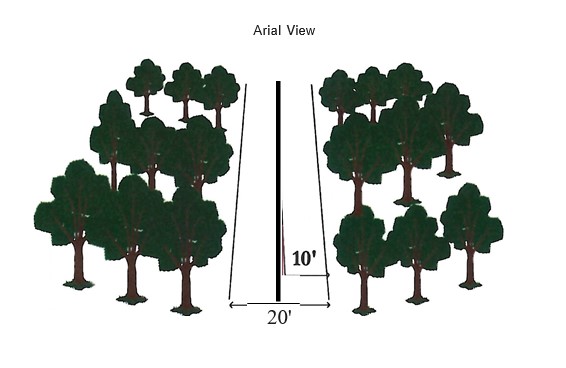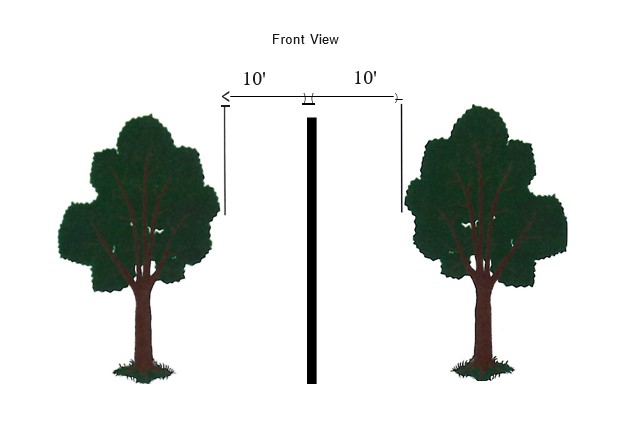Objective
To define the Cooperative’s vegetation management program to improve safety and electric service reliability. To increase member satisfaction and decrease member and landowner complaints due to vagueness and inconsistent applications of the Cooperative’s vegetation management programs. To be cognizant of vegetation management costs in providing a balance between member rates and landowner interests, while achieving high reliability standards, safety and overall satisfaction.
RIGHT-OF-WAY CLEARING / RE-CLEARING REQUIREMENTS
General
In 2014 NIEC’s Board of Directors identified a strategic imperative to improve safety and system reliability and has directed management to implement an extensive, 6-year reclamation of the rights of way. Aerial and mowing maintenance will be required to maintain rights of way to NIEC specification where a specified or desired right-of-way width has been established, re-established, or maintained.
All work is to be performed under the supervision of the Contractor. Work shall be conducted in a manner such that all phases of the clearing and/or re-clearing work shall progress concurrently, (i.e., cutting, disposal, and final cleanup). NIEC has the sole authority to designate the class of right-of-way. If any recent right-of-way clearing/re-clearing is encountered, and it does not conform to these specifications, it is to be reported to the authorized NIEC representative.
For those landowners where NIEC has documented easement rights, follow the Vegetation Management Procedure. For those situations where landowners are affected, when NIEC has no documented easement rights, and must rely on prescriptive rights, and the authorized NIEC representative has concluded clearing/trimming must occur, the Contractor shall contact the landowner and explain NIEC’s Vegetation Management Procedure.
If a landowner inquires about a line reroute/conversion, they shall be referred to the authorized NIEC representative.
Contractor personnel, during the process of notification, shall at all times present a professional appearance. Under no condition will a contractor employee be shirtless or wear sleeveless shirts. Each vehicle shall carry provided copies of NIEC’s “Authorization to perform work” letter to be used with member/landowner contacts.
All trimming on right-of-way boundaries shall be ground to sky. If the crown of a tree or any branches are within the right-of-way boundaries, even though the base of said tree is outside of right-of-way boundary, this tree will be considered as part of the Bid Project and shall be removed or trimmed to meet the guidelines.
All tree and brush species within the required right-of-way width shall be cut, leaving a stump three inches or less in height, or flush with the grade whenever possible. Exceptions are to be directed by the authorized NIEC representative.
Options for Refusals / Reluctance to Yield Right-of-Way in Approved Yard Applications:
Options to modify right-of-way clearing may be offered to individual landowners or groups of adjacent landowners that object to clearing according to the standards indicated by the NIEC right-of-way program. In providing these options, NIEC seeks to enable individual members to choose methods for right-of-way clearance that best address their concerns while preventing the burden of costs for use of non-standard procedures from being placed upon NIEC members as a whole.
Because of varying site conditions, not all options will be offered in all locations. Options that may be available for a particular site include:
Relocation of lines:
- Where consistent with NIEC standards for line maintenance/improvement, rerouting of lines or moving lines underground at the member’s expense will be considered. Rerouting must follow NIEC guidelines, and accessibility to the lines must be as good as or better than at the original location. In locations where groups of landowners must agree to rerouting, it is the responsibility of interested landowners to negotiate agreement with adjacent landowners and obtain necessary easements before rerouting can proceed. If such agreement cannot be obtained within a time frame specified by NIEC, right-of-way clearing will proceed unless other options are negotiated individually with NIEC.
Right-of-Way Width
NIEC’s right-of-way widths are 40 feet (both single and multiphase lines), measured perpendicularly from the centerline of the power line outward 20 feet in both directions. Right-of-way widths for underground line and overhead secondary line are 20 feet, measured perpendicularly from the centerline of the power line outward 10 feet in both directions.
The following definitions have been established for NIEC’s right-of-way program:
Maintained Yard Area:
Defined as a plot of land where a landowner has dedicated time and incurred expense to landscape, consistently tend to, and mow grass to an even height to establish a yard or yard-like area.
NIEC reserves the right to make the final determination of the above areas.
Single-Phase and Multi-Phase Lines:
40 feet (20 feet either side of the center line). Ground-to-sky cutting, trimming and mowing.
Underground and Overhead Secondary Lines:
20 feet (1O feet either side of the center line). Ground-to-sky cutting, trimming and mowing.
Note: All of NIEC’s right-of-way classification consists of a total 40 foot wide easement width regardless of vegetation width established in clearing activities. Exceptions to the above clearing activities shall be addressed individually and at the discretion of NIEC.
Mechanical Clearing and Re-clearing
Clearing and re-clearing work will be permitted by mechanical operations. Where the use of limbing machines is approved by NIEC, stubs of not more than 6 inches in length or a branch collar cut will be acceptable on any tree 4 inch in diameter or larger. Should 1/3 or more of the tree’s live crown area need to be reduced or removed to achieve the required clearances, the Contractor shall attempt to remove rather than trim. When the tree’s shape and appearance deviate from what is generally normal, the tree shall be considered for removal. Contractor will be responsible for going back and removing any stubs greater than 6 inches in length. After any mechanical operation, the Contractor shall restore the land in maintained yard areas to the natural contour existing prior to the start of the work. This must be accomplished to the complete satisfaction of NIEC and the landowner.
Selective Cutting
Selective cutting may be performed in specified areas designated by the authorized NIEC representative during the course of the contract period. These are generally areas of high public exposure (i.e. streams, lakes, maintained yard areas).
Primary Lines Rights-of-Way
The Contractor shall meet the required right-of-way width in designated areas by removing and/or trimming trees and other woody vegetation all diameter breasts height (dbh) classes. The work shall meet the authorized NIEC representative’s approval. Refer to Diagrams 1-2.
Secondary Lines Rights-of-Way
Secondary circuits are to be cleared only if authorized by NIEC’s representative.
Secondary circuits include all right-of-way between the NIEC owned pole with transformer and the final NIEC owned pole.
All limbs and branches within 10 feet of a secondary conductor shall be removed by natural pruning methods. Trees in which the main stem contacts secondary conductors shall be removed.
Secondary circuits will be assigned as necessary. Payment will either be by contractor’s submitted time and materials (T&M) rate or by accepted bid for each project as they develop.
Individual Services
Services are to be cleared only if authorized by NIEC’s representative. Tree limbs/branches contacting and deflecting individual service shall be trimmed to provide 10 feet of tree-to conductor clearance. Services are to be defined as the span from the last NIEC secondary pole to member’s meter. Method of payment will be contractor’s submitted time and material rate.
Overhead Guy Stubs
Clear within a 5-foot radius of a stub guy pole(s).
Anchors
Clear within a 5-foot radius of an anchor(s).
Primary Riser Poles with no overhead conductors attached.
Clear within a 20-foot radius around all underground primary riser poles.
Primary Poles
Clear within a 20 foot radius around all primary poles.
NOTIFICATION/ AUTHORIZATION
- An article describing NIEC’s vegetation management program and proposed Right-of-way clearing areas shall be published in the NIEC newsletter at least one time prior to the commencement of right-of-way clearing. The article shall include a map of the right-of-way clearing areas scheduled for vegetation management.
- Letters shall be mailed to members with property located within the designated right-of-way clearing areas notifying them of the proposed vegetation management to allow them time to relocate trees at their expense or to consider overhead to underground conversion options at the member’s expense; and/or to meet with NIEC personnel on site to assess the proposed vegetation management.
- An informational booth shall be available at NIEC’s annual meeting each year, so attendees can view the scheduled right-of-way clearing, ask questions of NIEC staff or schedule an on-site appointment with NIEC staff to assess the propose right-of-way clearing.
- The Contractor shall provide notification of intent to conduct the required right-of-way clearing by delivering a door-knob card to residences or businesses along the right-of-way clearing corridor. This contact shall precede any work done on any property by a minimum of five (5) working days. The work will then be scheduled for each crew. Any line clearance work done without proper notification must have specific approval by the authorized NIEC representative. NIEC must have 30-day notice requesting notification letters to be sent before any contact takes place.
- Verbal notification of the property owner for routine line clearance work is sufficient. If the property owner is not home, a notification card may be left on the door. Notification cards shall not be placed in any U.S. mailboxes.
- In the case of the industrial, municipal, county, state, or large private estate type of properties, the caretakers or other designated individual in the employ of the owners who is responsible for the trees or brush to be cut or trimmed is considered to represent the interest of the owner. Notification of such caretakers or grounds maintenance supervisors is acceptable.
- The contractor shall maintain a written daily log of all member notification and/or refusals by personal contact. The log shall include a record of the date of initial contact, party contacted, address, any agreements entered or understanding reached, and any follow-up conducted.
- If contractor is approached by a member any time during the performance of their work refusing the required trimming/clearing activities to/on their property or a specific tree(s), area(s), and or shrub(s), contractor shall honor the request and notify the NIEC authorized representative.
- If landowner refuses access to NIEC Rights of Way, Contractor shall notify authorized NIEC representative immediately.
COMPLAINTS AND ADJUSTMENT OF CLAIMS
- Complaints/claims of any nature received from property owners or those in authority over trees or brush removed or trimmed shall receive immediate attention by the Contractor. The Contractor shall immediately inform NIEC via the daily log of any property damage complaints, which may arise. The Contractor shall keep NIEC informed of the status of each complaint and of any settlement made with the damaged party. All claims shall be settled as soon as possible and to the reasonable satisfaction of NIEC and the landowner. Contractor shall inform authorized NIEC representative within two weeks of every damage claim that has been settled.
- The Contractor will be billed by NIEC for any unplanned interruptions to electrical service resulting from the Contractor’s actions (based on unsafe work practices on individual basis).
- The Contractor assumes entire responsibility and liability and shall adjust all property damage that should arise from Municipal, County, State, or Federal authorities or from property owners or owners of the abutting property sustained or alleged to have been sustained in connection with or to have arisen out of the performance of the work.
- The Contractor shall, without cost to NIEC, re-perform any work that does not comply with the terms of this agreement, including, but not limited to:
- Re-trimming if the work is not to the reasonable satisfaction of the authorized NIEC representative.
- Returning to an area to clean up debris left, or to remove a tree that should have been removed but was not.
- Repairing any and all damage to any property caused by Contractor to the reasonable satisfaction of NIEC and property owner. Including but not limited to; repair of all ruts, fences, and areas not completed to specification.
TRIMMING METHODS AND PROCEDURES
Tree trimming may be required where limbs of trees outside the clearing limits encroach the right-of-way. Trimming shall be performed as follows:
- Trim trees to provide maximum clearance per this document from NIEC’s facilities, consistent with current easement requirement.
- Re-establish or improve the clearance provided from all previous tree maintenance performed.
- All trees requiring trimming shall be trimmed at the edge of the clearing limits, unless otherwise agreed to with written consent from the landowner.
- The practices of flat-topping may only be permitted in the rarest of circumstances and at the discretion of NIEC.
- Tree trimming along the established tree edge shall involve the removal and/or trimming of limbs that are encroaching the right of way. Removal of the limbs will be back to the main stem, trunk, and/or to suitable live lateral branch.
- NOTE: Should one-third or more of the tree’s live crown area need to be reduced or removed to achieve the required clearances, the Contractor shall attempt to remove rather than trim. When the tree’s shape and appearance deviate from what is generally normal, the tree shall be considered for removal.
- Large diameter limbs shall be removed with proper sequence and placement of saw cuts to prevent stripping or tearing down of bark from the remaining limb or trunk.
- All slash (branches, limbs, and tops) which hang up in the tree(s) being pruned or in adjacent trees shall be removed before moving from the work site.
DANGER TREE REMOVAL METHODS AND PROCEDURES
- General
- For those landowners where NIEC has documented easement rights, follow the guidelines, methods and procedures outlined in this document. For those situations where landowners are affected, when NIEC has no documented easement rights, and must rely on prescriptive rights, and the authorized NIEC representative has concluded clearing/trimming must occur, the Contractor shall contact the landowner and explain NIEC’s guidelines, methods and procedures for line clearing.
- Contractor must investigate all trees along edge of right-of-way (including the opposite side of the road for lines adjacent to a road) for danger trees.
- A danger or hazardous tree is defined as a tree having one or more of the following characteristics, which may conflict with the conductors or structures (poles and hardware) if such tree(s) fell in the direction of or otherwise endangers the NIEC line. No danger or hazardous tree should be cut or removed if it cannot make contact with the conductors or structures when falling.
- Dead or dying – all dead or dying trees along, or outside the NIEC right-of-way. Removal depends on height of tree and direction of the lean.
- Leaning trees – trees that have such a lean toward the right-of-way that they cannot be trimmed without removing the tops and slanting the tree back. Removal depends on height and species of the tree and direction of the lean.
- Cankers and canker-rots – present as a localized area of dead bark and cambium on trees on the bark of trunk around the circumference of the tree and often are visible on the canker face. In some cases, canker-rots are internal and not visible.
- Animal and mechanical damage – present in the main trunk and broken branches, and must show visible signs of decay with evidence of wounds.
- Danger Tree Removals
- Contractor shall identify and remove dangerous or hazardous trees. In addition, removal of dangerous or hazardous yard trees is permitted to establish a right-of way and required clearances after discussion with the property owner.
- Contractor shall contact the authorized NIEC representative concerning questions on responsibility for danger tree removals. Generally, NIEC’s responsibility is to trim per guidelines and make the tree safe. All trees shall be felled away from the conductors and limbs, so that slash is close to ground. Slash from trees felled onto the right-of-way shall be placed at the edge of the right of way for landowner use. Slash in maintain yard areas shall be removed or chipped unless otherwise requested by the landowner.
- Stump/Stubble Height
- Whenever trees and brush are cut within or outside of the right-of-way, the cut stumps/stubble shall not be more than three (3) inches above ground and flush with the grade whenever possible.
CLEAN UP AND DISPOSAL PROCEDURES AND METHODS
- The Contractor, as the work progresses, shall remove all equipment, wood, branches, brush, and debris from the work site, and the work area shall be left in a neat, presentable condition. The Contractor shall dispose of all such material in accordance with applicable laws, rules, ordinances, and regulations and in accordance with the desire of property owners, occupants or NIEC, and at such times and in such a manner as to prevent injury to persons or property.
- All trees, brush, slash, and other debris shall be disposed of in accordance with the procedures and methods outlined below.
- Rural Sites
- Chipping/Grinding/Mechanical Mowing
- All cut material (slash) including tops and stem wood less than four inches in diameter shall be chipped or mowed. Resulting debris may be blown onto the site.
- Piling, Lopping and Scattering of Slash
- Piling, lopping, and scattering of slash and brush may be accomplished such that all material shall not exceed 3 feet in height. The method of disposal shall be limited to the outer one-third area of the right-of-way. In such areas, all logs shall be neatly piled parallel along the edge of the right-of-way. Wind-rowing of small diameter vegetation shall be permitted in or adjacent to wooded areas.
- Timber
- All merchantable timber from trees to be salvaged shall be trimmed flush to the trunk and neatly piled parallel along the edge of the right-of-way, in tree length or as specified otherwise by the authorized NIEC representative.
- Log piles shall not exceed 5 feet in height and shall be placed parallel along an outer edge of the right-of-way. At no time will log piles obstruct trails, access roads, the general construction area, or be piled up against standing trees on the edge of the right-of-way.
- All slash (branches, limbs, and tops) that hang up in the tree(s) being trimmed or in adjacent trees shall be removed before moving from current work site.
- Maintained Yard Areas
- All cut material/debris (slash) shall be removed from right-of-way crossing maintained yard applications. Large limb wood and trunk wood shall be removed and may only be left with consent of property owner. The work site shall be clear of all slash and debris upon completion of work on a daily basis. Wood chips may be made available to property owners upon request.
- All slash (branches, limbs, and tops) that hang up in the tree(s) being trimmed or in adjacent trees shall be removed before moving from current work site.
- Brush, and/or trees growing immediately adjacent to poles will be cut and removed. Vines do not have to be removed, but must be completely cut at the base of poles and guy wires.
- Rural Sites
PERFORMANCE AND SAFETY
- The Contractor shall at all times conduct the work in a manner as to safeguard the public from injury to persons or property.
- The Contractor shall use all necessary protection for its employees and to guard against interference with the normal operation of the circuits. If, in the judgment of the Contractor’s General Foreman/Supervisor, it is hazardous to trim or remove trees with the circuits energized, the authorized NIEC representative(s) shall be contacted. If deemed appropriate, the necessary protective or de-energized circuits will be provided by NIEC to ensure the safe removal of the affected tree parts.
- Should the Contractor knock down or come in contact with NIEC’s conductors, NIEC’s main office must be notified immediately. The following telephone number shall be used: 1-800- 762-4048.
- Contractor shall at all times take all reasonable precautions for the safety of employees on the work and of the public by utilizing safety equipment and methods in accordance with the manufacturer’s specifications on the herbicide label. Contractor shall comply with all applicable provisions of Federal, State and local laws. Contractor will furnish copies of any required licenses, certifications or permits and proof of insurance to NIEC upon request.
WORK SCHEDULING, TIMING AND REPORTING
- The Contractor shall report to the authorized NIEC representative. The following actives are included:
- Prior notification of work start-up and when adding or changing crew. Crew locations are to be given to the authorized NIEC representative.
- The Contractor shall contact the authorized NIEC representative on a periodic basis or as often as needed.
- Exaggerated, padded, or incorrect work report entries may result in the termination of the contract.
WORK NOTIFICATION, TIMING AND DOCUMENTS
- The scheduling of all firm price bid projects is the Contractor’s responsibility, except in cases of critical need, as determined by NIEC. NIEC may, at its discretion, require that specific sites be completed in order that reliability of service is maintained.
- The Contractor shall provide a five-(5) day notice to NIEC as to the date that the work will be starting on each circuit, the number and types of crews, and the crew foreman and supervisor’s names and telephone numbers. The Contractor shall also notify the authorized NIEC representative when there is a change in crew Foreman or the number of crews.
- The Contractor must notify NIEC of any work scheduled on Saturday, Sunday, holidays, or hours outside of NIEC’s normal hours of operations, subject to approval by the authorized NIEC representative.
- Crew’s starting and quitting times shall be determined by the Contractor.
- The Contractor shall make all necessary arrangements for crew starting points and garaging of equipment and shall be responsible for associated costs.
- NIEC properties will not be made available for the Contractor for crew starting points or for storing/garaging tools or equipment, unless authorized by the NIEC representative.
- In the event the Contractor plans to deviate from the normal work schedule (i.e., leaving the job or starting location due to inclement weather or other cause), the foreman and/or general foreman or supervisor shall call into the appropriate NIEC representative.
- The Contractor is responsible to ensure line clearance work is carried out on the proper project. Work performed on the wrong project will result in no payment for all work performed at that location.
- The Contractor shall keep NIEC informed as to the progress of the work with a logbook.
EMERGENCY WORK
In the event of an emergency declared by NIEC, the Contractor shall make the crews, supervision, and equipment performing under this contract available to perform work necessitated by the emergency. All emergency work shall be billed on a time and materials basis, for crews and equipment, in accordance with hourly rates.
Reference Diagrams
Diagram 1 RIGHT-OF-WAY CLEARING GUIDELINES (Single and Multi-Phase OHD Lines)


Diagram 2 RIGHT-OF-WAY CLEARING GUIDELINES (URD Primary and OHD Secondary Lines)


